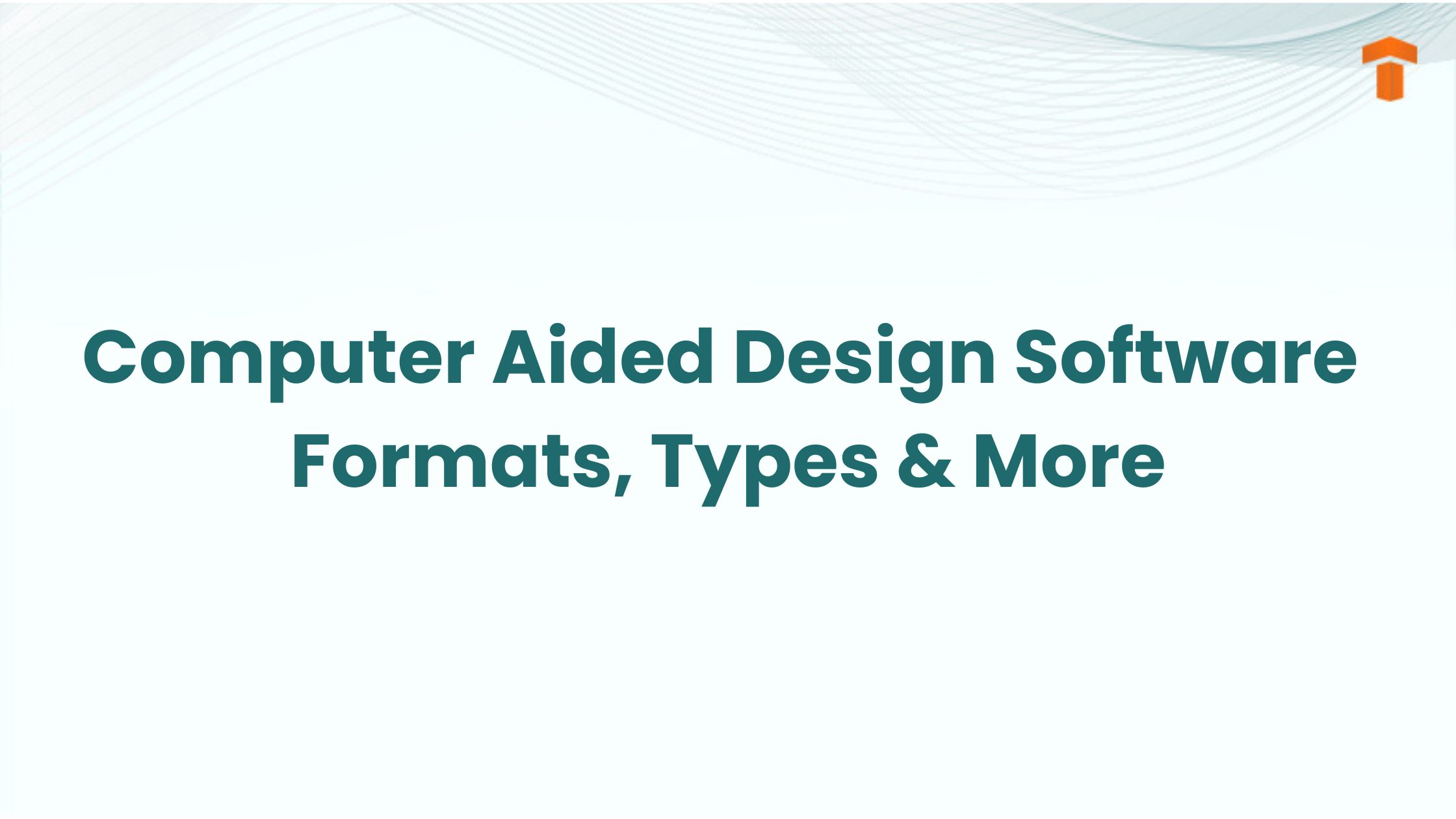Computer Aided Design Software | Formats, Types & More
Mar 10, 2025
Category: BIM / Digitization / Automation
Admin

Computer-Aided Design (CAD) has become a buzzword in various 2D and 3D design industries. This invention empowered designers to switch from creating technical drawings by hand to designing on a computer.
It has fostered precision, cost, and time efficiency in the design process.
Engineers, architects, designers, drafters, and crafters leverage the multifold features of CAD today. In this write-up, let’s learn more about this cutting-edge software.
What is Computer-Aided Design?
CAD is one of the most popular software programs for creating 2D and 3D digital models of real-world products and objects before manufacturing. Architects, engineers, and designers used to draft designs manually, which was slow and labor-intensive. However, manual drafting did not offer the same level of detail and accuracy as this software.
Today, futuristic CAD tools offer unparalleled ease in sharing, testing, and modifying product drafts. The continuous evolution of CAD tools promises greater efficiency in designing operations for several industries.
Types of CAD
2D and 3D CAD are the most common. However, a 2.5 CAD version is also available. Let’s find out more about them.
2D CAD
The first 2D CAD system was invented in the early 1970s. Large industries such as automotive, aerospace, and other engineering firms started using it to automate repetitive drafting tasks.
2D CAD creates flat drawings using fundamental geometric shapes such as rectangles, lines, circles, and arcs.
This software uses dimensions, text, leaders, and tables to annotate drawings. Designing, sectioning, planning, detailing structures, and representing elevation views in the built environment become easier with it. Furthermore, designers can illustrate the functions of various components working in tandem to form assemblies. They also get crucial insights into the areas that may need an additional inspection.
The unique features, such as generating bills for the material purchases, a library of geometric images, the ability to specify hatching patterns, and splines, bezier curves, and polylines designing capacity make it an exceptional software. Some of the most widely adopted 2D CAD applications are AutoCAD, CATIA, KeyCreator, and MEDUSA4.
2.5D CAD
It is the intermediary version that includes aspects of 2D and 3D software. An object’s depth is demonstrated by 2.5D CAD in geometric shapes, which is similar to 2D CAD. However, this software visualizes the height of an object at different points using contour maps. Professionals use this type of CAD for computer numerical control (CNC) machining as it helps in drawing parts having several flat surfaces at different depths.
3D CAD
This type of CAD is at the core of the design industry as it offers enhanced computer processing power and graphic display capabilities. Improved precision and realism in the models created by 3D CAD software have empowered the designers to resolve potential issues early. Below are the three major categories of this software:
Solid Modeling
A 3D image depicting an object’s volume is referred to as solid modeling. It demonstrates the object’s geometry comprehensively and precisely.
Wireframe Modeling
A wireframe model illustrates the edges of an object using lines and curves. In other words, it offers a skeletal view that does not have surface details.
Surface Modeling
A surface model defines an object’s exterior shape to depict complex surfaces. This model type aids designers in intricate and detailed designing.
Autodesk Inventor, ZW3D, CATIA V5, and Blender are the prominent names in the 3D CAD software category.
CAD File Formats
Native and neutral are the two types of CAD file formats.
Neutral
This type of file format supports various software systems. Neutral file formats are universal and enable the users to work with them using different software. No matter which tool one uses, they have to use the STEP format (STandard for the Exchange of Product model data) to transfer the data. More of these file types are mentioned below:
- Stereo Lithography, or STL (.stl)
- 3D Portable Document Format, or PDF (.pdf)
- Initial Graphics Exchange Specification, or IGES (.igs, .iges)
- Drawing Interchange Format, or DXF files (.dxf)
Although users can experience improved interoperability with neutral files, they may have issues while importing or exporting data. In other words, they may not work the same way.
Native
Native CAD files refer to the ones used by some CAD tools exclusively. Professionals can only view these files using the same tool that created them. Hence, it may not be possible to open such files on the other software. However, native files ensure high quality and optimal performance.
Suitable features and functions of a specific software make it possible, as the tool can interpret the data well. Here are some of the native file formats:
- AutoCAD (.dwg)
- SolidWorks (.sldprt and .sldasm)
- Altium (.SchDoc and *.PcbDoc)
- CATIA V5 (.CATPart and CATProduct)
Top CAD Software
AutoCAD
Autodesk’s AutoCAD is the veteran and most popular in this list. It has gained numerous followers, especially from the architectural and industrial engineering sectors. This application simplifies 2D and 3D drafting and design.
Whether it is about creating designs, section planes, equipment layouts, model documentation, or more, this tool offers exceptional performance. Engineers, architects, designers, students, surveyors, construction managers, project managers, and other professionals use AutoCAD.
CATIA
CATIA was developed by Dassault Systèmes and contributes immensely in various fields such as computer-aided design, engineering, and manufacturing. Sometimes, people refer to it as a 3D product lifecycle management platform. Organizations such as NASA, Boeing, Lockheed Martin, and VW from the defense and aerospace sectors use this tool.
SolidWorks
SolidWorks is also a product from Dassault Systèmes and is ideal software for professionals working on 3D designs. The main feature of this tool is parametric modeling, and it is also capable of 2D modeling.
This 3D modeling CAD software has the tagline “built by engineers, for engineers.” Hence, it has major applications in the mechanical field.
FreeCAD
This software equips the users with leading-edge tools to create 2D and 3D drawings. It has applications in product design, architecture, and mechanical engineering. Open CASCADE technology is the base for the advanced geometry engine.
Creating architectural models, 2D CAD drafts, CNC designs, and more is easy by using this tool. Furthermore, it is free and can run efficiently on Mac, Linux, and Windows.
Altium
Altium is a CAD software developed for designing printed circuit boards (PCBs). Most electric devices have it as a standard element. Managing complex circuitry, including high-density interconnect (HDI) boards, gets easier for designers using this tool. It facilitates the designers in creating electronic designs that extend a board’s lifespan, whether it is schematics, manufacturing files, or more.
Applications of CAD in Different Industries
Architecture
This software aids architects in creating technical drawings, which are also called blueprints. These technical drawings illustrate any layout, such as an elevation, section, or floor plan. It is easy to demonstrate the top-down view of the size, room shapes, location, and other objects using floor plans and scaled diagrams.
It is an excellent tool for simulating energy efficiency, structural integrity, and lighting through models before construction commences.
Civil Engineering and Public Services
A civil engineer’s job roles include working on utilities and infrastructure, such as bridges, roads, waste disposal, water systems, and more. They can leverage CAD to create intricate models of infrastructure, including various maps such as navigation, cadastral, and topography.
CAD models are also helpful for them in maintenance projects. Additionally, it allows simulation of possible impacts of changes to the landscape on existing resources.
Transportation and Aerospace
Computer-aided design aids in the initial stage prototyping of vehicles such as airplanes, cars, trucks, and space shuttles. Professionals can use the designed models to conduct tests for structural integrity, aerodynamics, and safety before creating the vehicles in the real world.
Furthermore, integrating this software with automated manufacturing processes promotes quality and consistency.
Engineering and Construction
This tool has a significant role in the BIM (Building Information Modeling) process. It contributes to the creation and management of a building’s virtual model. Engineers use the 2D and 3D drawing features of this software during the design and drafting.
They can also showcase a building’s structural integrity in various physical conditions by simulating models. Project stakeholders such as architects, engineers, and contractors can collaborate well using this application.
Product Design and Manufacturing
Project designers and manufacturers can harness CAD to create 3D models of products, which is a smart choice before developing physical prototypes. This way, predicting the performance, durability, and functionalities of a product is simplified as these models can simulate real-world conditions.
Tool paths created on CAD models are used by CNC machines. They also contribute to the creation and preparation stages of drawings for additive manufacturing.
Conclusion
Computer-aided design (CAD) software has major uses in product engineering as well as several other fields. It simplifies the creation, testing, and optimization of design without investing in developing prototypes.
Product manufacturing stakeholders can experience enhanced collaboration among them. It offers record specifications and a documentation trail. Hence, organizations must comprehend the key concepts of CAD and how it works to amplify efficiency in designing operations.








